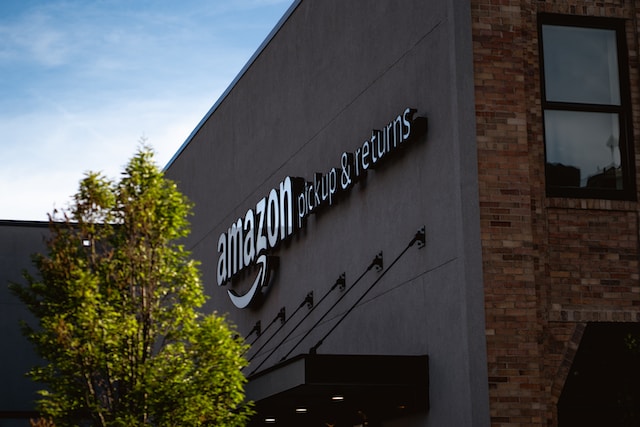Before we dive deep into the PESTEL analysis, let’s get the business overview of Amazon. Amazon.com, Inc. is a multinational technology company based in Seattle, Washington. Founded by Jeff Bezos in 1994, the company initially started as an online marketplace for books but later expanded to sell electronics, software, video games, apparel, furniture, food, toys, and jewelry. Here is an overview of Amazon’s business:
E-commerce: Amazon.com, the company’s primary platform, is one of the largest online retailers in the world. Amazon offers millions of new, refurbished, and used items in categories such as books, movies, music, games, electronics, toys, men’s/women’s clothing, sports, tools, etc.
Amazon Prime: A membership program offering free two-day shipping on many items, access to streaming video and music, and other benefits for a monthly or yearly fee.
Amazon Marketplace: This platform allows third-party sellers to sell new or used products alongside Amazon’s regular offerings. Many small businesses use Amazon Marketplace as their primary online retail channel.
Amazon Web Services (AWS): A suite of cloud-based services, including computing power, storage, and databases, available on demand and charged based on usage. AWS is a major source of revenue for Amazon, and it powers many popular websites and services.
Amazon Devices: Amazon develops and sells electronic devices, most notably the Kindle e-readers, Fire tablets, Fire TV streaming devices, and Echo devices, which house Amazon’s virtual assistant, Alexa.
Digital Content: Amazon provides digital content, including movies, music, and books, through its platforms like Amazon Music, Amazon Video, and the Kindle Store.
Amazon Fresh and Whole Foods: Amazon operates in the grocery sector with Amazon Fresh, its grocery delivery service, and Whole Foods, a supermarket chain it acquired in 2017.
Physical Stores: Beyond Whole Foods, Amazon has a physical retail presence through Amazon Books (a chain of bookstores), Amazon Go (a chain of cashier-less convenience stores), and Amazon 4-star (stores that feature products rated 4 stars and above, top sellers, or new and trending items on Amazon.com).
Amazon Logistics: Besides using third-party couriers, Amazon operates its own logistics network, including delivery vans, trucks, airplanes, and even drones under development for future delivery.
Advertising Services: Amazon runs an advertising business where advertisers can display their products to potential customers on Amazon’s websites and mobile apps.
Other Ventures: Amazon has numerous other ventures, including Amazon Studios (film and TV production), Amazon Game Studios (video game development), and more.
- Net sales increased 9% to $514.0 billion in 2022, compared with $469.8 billion in 2021.
- Operating income decreased to $12.2 billion in 2022, compared with $24.9 billion in 2021.
- Free cash flow decreased to an outflow of $11.6 billion for the trailing twelve months, compared with an outflow of $9.1 billion for the trailing twelve months ended December 31, 2021.
“All-Inclusive” business model of Amazon Prime
Here is the PESTEL analysis of Amazon
A PESTEL analysis is a strategic management framework used to examine the external macro-environmental factors that can impact an organization or industry. The acronym PESTEL stands for:
- Political factors: Relate to government policies, regulations, political stability, and other political forces that may impact the business environment.
- Economic factors: Deal with economic conditions and trends affecting an organization’s operations, profitability, and growth.
- Sociocultural factors: Relate to social and cultural aspects that may influence consumer preferences, lifestyles, demographics, and market trends.
- Technological factors: Deal with developing and applying new technologies, innovations, and trends that can impact an industry or organization.
- Environmental factors: Relate to ecological and environmental concerns that may affect an organization’s operations and decision-making.
- Legal factors: Refer to the laws and regulations that govern businesses and industries.
In this article, we will do a PESTEL Analysis of Amazon.
PESTEL Analysis Framework: Explained with Examples
Political
- Regulatory Environment: Amazon operates in many different countries, each with its regulations. E-commerce, tax, and data protection policies vary significantly across regions. Compliance with these regulations is essential for Amazon to maintain its operations smoothly.
- Trade Policies: Trade policies, including import-export regulations, tariffs, and trade agreements, significantly impact Amazon’s operations. For example, changes in US-China trade policies can affect Amazon’s supply chain costs and product pricing.
- Political Stability: The political stability of the countries in which Amazon operates can influence its business. For instance, political instability can disrupt Amazon’s supply chains, increase operating costs, and harm the company’s reputation.
- Tax Laws: Changes in tax laws in different countries can impact Amazon’s profitability. For example, US corporate tax rate changes or EU tax laws can significantly affect Amazon’s financial performance.
- Data Privacy and Security Laws: As an internet-based company, Amazon handles enormous amounts of customer data, making data protection laws in different countries crucial to its operations. New regulations like the GDPR in Europe and the CCPA in California impact how Amazon collects, stores, and uses customer data.
- Labor Laws: These laws can affect Amazon’s human resources practices, particularly around minimum wage, working hours, and working conditions. Amazon’s fulfillment centers have been in the spotlight in several countries due to allegations of poor working conditions, leading to increased political scrutiny.
- Environmental and Sustainability Regulations: Governments worldwide are strengthening their environmental protection and sustainability regulations. These regulations may affect Amazon’s packaging, logistics, and waste management practices.
Economic
- Global Economic Conditions: The state of the global economy significantly impacts Amazon’s performance. During periods of economic prosperity, consumers typically have more disposable income to spend, which can increase sales. However, during a recession, consumers may cut back on non-essential spending.
- Exchange Rates: Amazon operates globally and is exposed to exchange rate fluctuations. A stronger dollar might mean lower sales in non-US markets due to increased customer prices. Conversely, a weaker dollar can make Amazon’s products more affordable in those markets.
- Inflation Rates: Changes in inflation can affect purchasing power. High inflation can reduce consumers’ buying power and, consequently, the demand for Amazon’s products and services.
- Unemployment Rates: High unemployment rates can decrease consumer spending power, reducing demand for non-essential products and services. On the other hand, low unemployment rates can increase consumer confidence and boost spending.
- Interest Rates: Interest rates can affect Amazon’s costs. For instance, if Amazon borrows money to fund its operations or investments, higher interest rates increase the cost of borrowing and vice versa.
- Consumer Confidence Index: The level of consumer confidence impacts how willing consumers are to make purchases. High consumer confidence can translate to increased sales for Amazon, while low confidence can have the opposite effect.
- E-Commerce Market Growth: The growth rate and maturity of the e-commerce market in different regions affect Amazon’s potential for growth. For example, a rapidly growing e-commerce market in Southeast Asia presents significant growth opportunities.
- Technological Infrastructure: The state of technological infrastructure in different countries, like internet penetration and digital payment systems, also impacts Amazon’s business.
- Transportation Costs: Fuel prices, logistics costs, and infrastructure quality can influence Amazon’s shipping costs and delivery efficiency.
Sociocultural
- Consumer Attitudes and Behavior: Changes in consumer behavior, such as the increasing preference for online shopping and the expectation of fast delivery, play a significant role in Amazon’s growth. Amazon must stay attuned to shifts in consumer behavior to maintain its relevance and competitiveness.
- Demographics: Demographic shifts such as age distribution, population growth rates, and income levels can influence Amazon’s market segments. For example, an aging population may increase the demand for certain products or services, while a younger demographic might be more inclined toward digital products and services.
- Cultural Differences: Amazon operates globally, meaning it must understand and cater to various cultural preferences and norms. For instance, preferences for certain types of products, payment methods, or even the prominence of local competitors can vary substantially between countries.
- Lifestyle Trends: Trends in how people live, work, and spend their leisure time can significantly impact Amazon’s business. For example, the trend towards remote work and home-based activities during the COVID-19 pandemic boosted demand for home office supplies, home entertainment, and online grocery shopping.
- Ethical and Social Responsibility: There’s an increasing consumer expectation for companies to operate responsibly and sustainably. Issues like working conditions in Amazon’s warehouses, the environmental impact of its operations, and its role in the local communities it operates in can influence consumer perceptions and attitudes towards Amazon.
- Health Consciousness: With growing health consciousness, there is an increased demand for health-related products, organic food, and fitness equipment. Amazon can leverage this trend by offering a more comprehensive range of such products.
- Digital Literacy: The level of digital literacy among a population can affect the adoption rate of online shopping and digital services, impacting Amazon’s potential market size in different regions.
Technological
- Innovation in E-commerce: Amazon is renowned for its innovation in the e-commerce sector. As technology evolves, the company must keep up with or lead advancements in personalized shopping experiences, secure payment systems, and virtual reality shopping.
- Advancements in AI and Machine Learning: Amazon utilizes AI and machine learning in its business, including recommendation algorithms, demand forecasting, fraud detection, and warehouse automation. The development and application of these technologies are crucial for Amazon to maintain its efficiency and competitive edge.
- Cloud Computing: Amazon Web Services (AWS) is a leading player in the cloud computing market. Advances in this technology, such as edge computing and quantum computing, can provide significant opportunities for AWS to grow and innovate.
- Digital Payment Systems: Technological advancements in digital payment systems can enhance the ease and security of online transactions, thereby improving the customer experience on Amazon.
- Blockchain Technology: Blockchain can potentially impact Amazon in areas such as supply chain transparency and secure payment processing.
- Internet of Things (IoT): The growth of IoT presents opportunities for Amazon in areas like smart home devices. Amazon’s Echo devices and Alexa voice assistant are examples of Amazon’s efforts in this area.
- Logistics and Delivery Technology: Innovations in logistics technology, such as drone deliveries, autonomous vehicles, and advanced robotics, can help Amazon increase the efficiency of its supply chain and fulfillment processes.
- Cybersecurity: As a digital company handling vast amounts of customer data, staying ahead of cybersecurity threats is essential for Amazon. Technological advancements in cybersecurity can help the company protect its operations and maintain customer trust.
- Mobile Technology: The growth and advancement of mobile technology affect how consumers interact with Amazon. Enhancements in mobile connectivity (like 5G) can provide a faster and more seamless shopping experience for Amazon customers.
Environmental
- Climate Change: Global climate change and associated regulations can significantly impact Amazon’s operations, particularly its supply chain, and logistics. Extreme weather events can disrupt its delivery network, and regulations to reduce carbon emissions might necessitate changes in Amazon’s operations.
- Sustainable Packaging: There is increasing consumer and regulatory pressure to reduce packaging waste. Amazon, shipping millions of packages daily, faces significant scrutiny regarding its use of packaging materials. Innovations in sustainable packaging can allow Amazon to reduce its environmental footprint.
- Renewable Energy: Amazon has committed to powering its operations with 100% renewable energy as part of its sustainability goals. Progress and innovations in renewable energy technologies can directly impact Amazon’s ability to achieve these goals.
- Waste Management: As a major retailer, Amazon must consider the life cycle of its products, including disposal and potential for recycling. Consumer preferences are shifting towards products with minimal environmental impact, and regulations around electronic waste and single-use items are increasing.
- Carbon Footprint: Amazon’s operations, particularly logistics and data centers, have a substantial carbon footprint. The company’s ability to reduce emissions can impact its reputation, regulatory compliance, and appeal to environmentally-conscious consumers.
- Biodiversity and Conservation: Amazon’s operations can impact biodiversity through its supply chains. Attention to sustainable sourcing and efforts to mitigate habitat impacts can be significant.
- Water Usage: Although less directly impactful for Amazon than for companies in sectors like manufacturing or agriculture, water usage can still be relevant, particularly in operating Amazon’s data centers.
Legal
- Data Protection Laws: Amazon handles a vast amount of user data, so it must comply with data protection regulations in all markets it operates in. These include the General Data Protection Regulation (GDPR) in the European Union, the California Consumer Privacy Act (CCPA) in the United States, and similar regulations elsewhere.
- Tax Laws: Amazon operates globally and is subject to different tax laws and regulations in various countries. Changes in these laws can impact Amazon’s profitability.
- Consumer Protection Laws: Amazon must ensure its business practices comply with various consumer protection laws regarding product safety, marketing, and sales practices, as well as after-sales service.
- Antitrust and Competition Laws: Amazon has faced scrutiny from competition regulators in several regions, including the US and EU, over its market dominance and business practices. Antitrust law and enforcement changes could have significant implications for Amazon’s operations.
- Intellectual Property Laws: Amazon must navigate intellectual property laws to protect its own IP (like its technology and brand) and to avoid infringing on the rights of others (such as counterfeit goods sold through its marketplace).
- Employment Laws: With its large workforce, Amazon must adhere to employment laws and regulations in different countries, including wages, working conditions, and labor rights.
- E-commerce Regulations: As one of the world’s largest e-commerce companies, any changes in laws and regulations pertaining to online retail, digital services, and internet businesses can have a significant impact on Amazon.
- Environmental Laws: Amazon must comply with environmental laws in various countries, which can relate to aspects like waste disposal, emissions, and product standards. For example, electronic products sold by Amazon must comply with electronic waste regulations.











